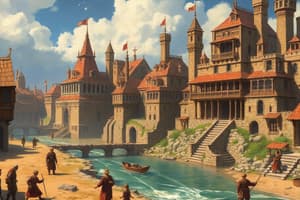Podcast
Questions and Answers
Which historical period is commonly referred to as the medieval period?
Which historical period is commonly referred to as the medieval period?
- 8th to 18th century BCE
- 10th to 20th century CE
- 3rd to 13th century CE
- 5th to 15th century BCE (correct)
What was a key characteristic of feudalism in medieval Europe?
What was a key characteristic of feudalism in medieval Europe?
- Landholding lords granting fiefs in exchange for military service (correct)
- Religious tolerance
- Monarchy rule
- Trade dominance
Which ruler of the Mughal dynasty broadened the empire through diplomacy rather than warfare?
Which ruler of the Mughal dynasty broadened the empire through diplomacy rather than warfare?
- Shah Jahan
- Aurangzeb
- Jahangir (correct)
- Babur
What aspect of artistry flourished during Jahangir's reign?
What aspect of artistry flourished during Jahangir's reign?
Which Mughal ruler succeeded Akbar as the emperor?
Which Mughal ruler succeeded Akbar as the emperor?
What kind of empire did Babur establish in the early 16th century?
What kind of empire did Babur establish in the early 16th century?
What did Shah Jahan focus on during his reign as the Mughal Emperor?
What did Shah Jahan focus on during his reign as the Mughal Emperor?
How did Shah Jahan's extravagant lifestyle impact the Mughal Empire?
How did Shah Jahan's extravagant lifestyle impact the Mughal Empire?
What distinguished Aurangzeb's reign from his predecessors Jahangir and Shah Jahan?
What distinguished Aurangzeb's reign from his predecessors Jahangir and Shah Jahan?
How did Aurangzeb's strict implementation of Shariah law affect the Mughal Empire?
How did Aurangzeb's strict implementation of Shariah law affect the Mughal Empire?
Which king among Jahangir, Shah Jahan, and Aurangzeb was primarily known for military expansion?
Which king among Jahangir, Shah Jahan, and Aurangzeb was primarily known for military expansion?
What historical significance do the reigns of Jahangir, Shah Jahan, and Aurangzeb collectively hold?
What historical significance do the reigns of Jahangir, Shah Jahan, and Aurangzeb collectively hold?
Flashcards are hidden until you start studying
Study Notes
Medieval Times in Europe and Mughal Empires of India
The Middle Ages, commonly known as the medieval period, span from roughly the 5th century CE to the 15th century CE. This era witnessed profound changes across continents, including both Europe and South Asia's Indian subcontinent. While our focus is primarily on the latter with the rulers Shah Jahan, Jahangir, and Aurangzeb of the Mughal dynasty during this time, it helps to understand some common themes between these historical epochs.
In Europe, feudalism was prevalent, characterized by landholding lords who granted lands called fiefs to their vassals in return for military service and loyalty. In contrast, the Indian subcontinent experienced the rise of powerful empires such as the Gupta Empire and the Delhi Sultanate before reaching its zenith under the Mughal Dynasty founded by Babur in the early 16th century.
Mughal Rule: Three Key Rulers
1) Jahangir
Jahangir succeeded his father, Akbar, around 1605 CE and broadened the empire through diplomacy rather than warfare like many other monarchs did earlier. He successfully managed relations with neighboring kingdoms while also strengthening trade ties with European countries like Portugal and England. His reign saw the development of artistry, especially miniature painting, which flourished until the Mughal decline.
2) Shah Jahan
Shah Jahan took over in 1628 CE after deposing his wife Nur Jahan and son Khurram due to political ambitions, eventually crowning him as prince and heir apparent. Known for architectural masterpieces, particularly the Taj Mahal (built in memory of his deceased wife Mumtaz), he worked towards consolidating the gains made during his predecessor's rule and revived faltering finances. However, his extravagant lifestyle led to increased taxation and discontent among the populace.
3) Aurangzeb
Aurangzeb ascended the throne in 1659 CE following years of intense infighting within his family. Unlike his two predecessors, Aurangzeb's tenure marked a significant shift in policy; he embarked upon religious reforms mainly focused on the imposition of Islamic laws throughout the realm, leading to conflict with Hindu rulers in the Deccan region. Although initially successful militarily, Aurangzeb's strict implementation of Shariah law ultimately weakened the Mughal Empire and contributed to its downfall.
Each of these three kings followed different paths—from diplomacy and cultural development to military expansion and religious orthodoxy—to shape the destiny of the Mughal Empire. Their reigns exemplify how various factors influenced the course of history during the medieval age in both Europe and India.
Studying That Suits You
Use AI to generate personalized quizzes and flashcards to suit your learning preferences.




